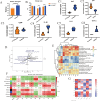Succession of rumen microbiota and metabolites across different reproductive periods in different sheep breeds and their impact on the growth and development of offspring lambs
- PMID: 39267132
- PMCID: PMC11397069
- DOI: 10.1186/s40168-024-01892-z
Succession of rumen microbiota and metabolites across different reproductive periods in different sheep breeds and their impact on the growth and development of offspring lambs
Abstract
Background: The microbiota and metabolites in the gastrointestinal tracts of female animals at different reproductive periods are very important to the growth, development, and health of themselves and their offspring. However, the changes in the gastrointestinal microbiota and metabolites throughout reproductive period of different sheep breeds and their effects on the growth and development of offspring lambs are still unclear. Hence, this study presents an assessment of the reproductive hormone levels, immune levels, rumen microbiota, and metabolites in Hu sheep and Suffolk ewes at different reproductive periods and their effects on the growth and development of offspring lambs.
Results: Hu sheep and Suffolk during non-pregnancy, pregnancy, and lactation were used as the research objects to determine reproductive and immune indexes of ewes at different periods, analyze rumen microbiome and metabolome, and track the growth performance and development of offspring lambs. The results showed that the reproductive hormone and immune levels of Hu sheep and Suffolk underwent adaptive changes across different reproductive periods. Compared with non-pregnancy, the microbial energy metabolism and lipid metabolism function decreased during Hu sheep pregnancy, and energy metabolism function decreased during lactation. In Suffolk, energy metabolism, glycan biosynthesis, and metabolism function were enhanced during pregnancy, and the metabolism of cofactors and vitamins was enhanced during lactation. Prevotella increased in Suffolk during pregnancy and lactation (P < 0.05) and was positively correlated with the birth weight and body size of the lambs (P < 0.05). Moreover, the abundances of Butyrivibrio and Rikenellaceae_RC9_gut_group during pregnancy were positively correlated with the intestinal immunity of the offspring lambs (P < 0.05), thereby regulating the intestinal immunity level of the lambs. Metabolomic analysis revealed that the protein digestion, absorption, and amino acid metabolism of Hu sheep were enhanced during pregnancy, which provided amino acids for the growth and development of pregnant ewes and fetuses and was significantly correlated with the birth weight, body size, and intestinal immunity of lambs (P < 0.05). Simultaneously, there was an increase in acetate and propionate during the pregnancy and lactation period of both Hu sheep and Suffolk, providing energy for ewes during reproductive period. Moreover, the microbiota during the lactation period was significantly correlated with the milk quality and lambs daily gain (P < 0.05).
Conclusions: This study revealed the characteristic succession changes in the rumen microbiota and its metabolites at different reproductive periods in sheep breeds and their regulation of reproductive hormone and immune levels and identified their potential effects on the growth and development of offspring lambs. The findings provide valuable insights into the health and feeding management of different sheep breeds during the reproductive stage. Video Abstract.
Keywords: Immune function; Lambs; Metabolites; Reproductive period; Rumen microbiota.
© 2024. The Author(s).
Conflict of interest statement
The authors declare no competing interests.
Figures








Similar articles
-
Dietary resveratrol improves immunity and antioxidant defense in ewes by regulating the rumen microbiome and metabolome across different reproductive stages.Front Immunol. 2024 Oct 11;15:1462805. doi: 10.3389/fimmu.2024.1462805. eCollection 2024. Front Immunol. 2024. PMID: 39464877 Free PMC article.
-
Sex-induced alterations in rumen microbial communities and metabolite profiles: implications for lamb body weight.BMC Microbiol. 2025 May 27;25(1):328. doi: 10.1186/s12866-025-04049-6. BMC Microbiol. 2025. PMID: 40426040 Free PMC article.
-
The impact of lactating Hu sheep's dietary protein levels on lactation performance, progeny growth and rumen development.Anim Biotechnol. 2023 Nov;34(6):1919-1930. doi: 10.1080/10495398.2022.2058006. Epub 2022 Apr 13. Anim Biotechnol. 2023. PMID: 35416756
-
Host-gut microbiota interactions during pregnancy.Evol Med Public Health. 2024 Jan 6;12(1):7-23. doi: 10.1093/emph/eoae001. eCollection 2024. Evol Med Public Health. 2024. PMID: 38288320 Free PMC article. Review.
-
The microbiota: a key regulator of health, productivity, and reproductive success in mammals.Front Microbiol. 2024 Nov 5;15:1480811. doi: 10.3389/fmicb.2024.1480811. eCollection 2024. Front Microbiol. 2024. PMID: 39633815 Free PMC article. Review.
Cited by
-
Effect of Roughage Source on the Composition and Colonization of Rumen Bacteria and Methanogens in Dumont and Mongolian Sheep.Animals (Basel). 2025 Jul 14;15(14):2079. doi: 10.3390/ani15142079. Animals (Basel). 2025. PMID: 40723543 Free PMC article.
-
Rumenomics: Evaluation of rumen metabolites from healthy sheep identifies differentially produced metabolites across sex, age, and weight.bioRxiv [Preprint]. 2025 Feb 8:2025.02.05.636747. doi: 10.1101/2025.02.05.636747. bioRxiv. 2025. PMID: 39975146 Free PMC article. Preprint.
-
Characterizing the seminal microbiota in mature rams managed on divergent planes of nutrition, and their male offspring.J Anim Sci. 2025 Jan 4;103:skaf171. doi: 10.1093/jas/skaf171. J Anim Sci. 2025. PMID: 40371922
-
Physiological and Microbial Community Dynamics in Does During Mid-Gestation to Lactation and Their Impact on the Growth, Immune Function, and Microbiome Transmission of Offspring Kids.Animals (Basel). 2025 Mar 26;15(7):954. doi: 10.3390/ani15070954. Animals (Basel). 2025. PMID: 40218348 Free PMC article.
-
Synergistic transcriptomic and metabolomic analyses in Zi geese ovaries with different clutch lengths.Poult Sci. 2025 Jul;104(7):105210. doi: 10.1016/j.psj.2025.105210. Epub 2025 Apr 23. Poult Sci. 2025. PMID: 40294555 Free PMC article.
References
-
- Rosales-Nieto CA, Rodriguez-Aguilar M, Santiago-Hernandez F, Cuevas-Reyes V, Flores-Najera MJ, Vazquez-Garcia JM, et al. Periconceptional nutrition with spineless cactus (Opuntia ficus-indica) improves metabolomic profiles and pregnancy outcomes in sheep. Sci Rep. 2021;11(1):7214. 10.1038/s41598-021-86653-w. 10.1038/s41598-021-86653-w - DOI - PMC - PubMed
MeSH terms
Grants and funding
- 23JRRA1447/Gansu Province science and technology plan project
- 22CX2NA005/Gansu Province science and technology plan project technology innovation guidance program - LuGan Science and technology collaboration topic
- LXZC21520230202/Guanghe County cattle and sheep industry quality and efficiency technology demonstration project
LinkOut - more resources
Full Text Sources

